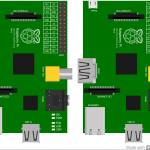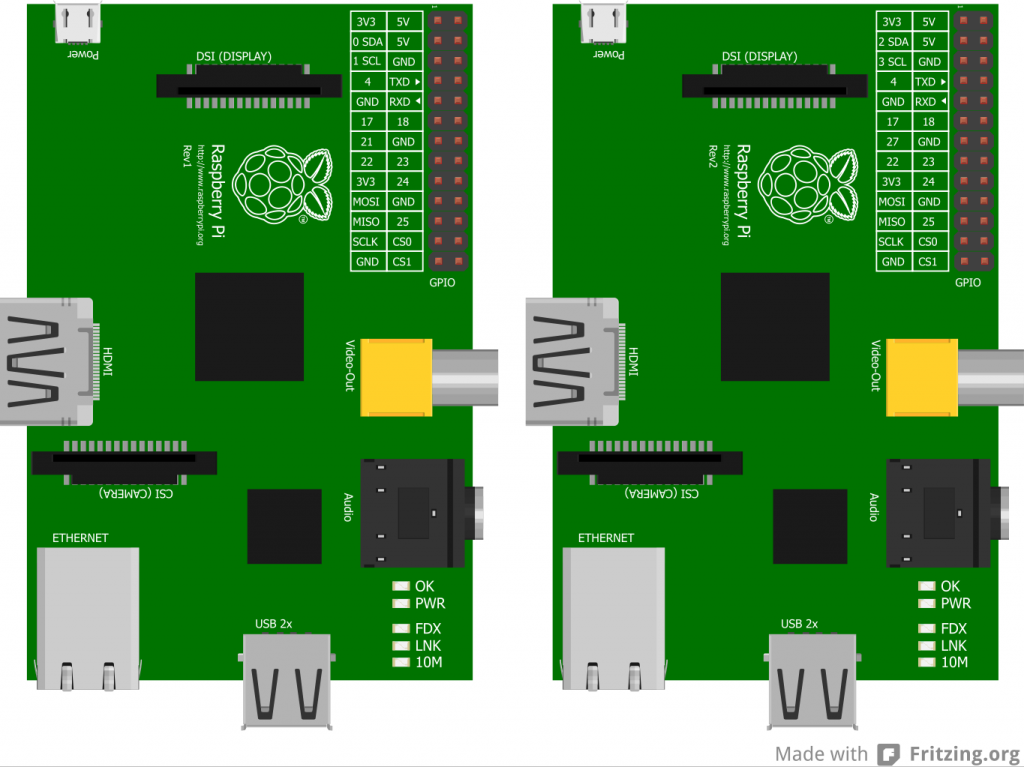
Over the last few days, the guys at Fritzing have been busy – they’ve released three new versions in three days.
What’s Fritzing? I hear you ask. It’s an excellent Free Open Source program for doing circuit diagrams, board design etc. I use it a lot for my circuit diagrams on RasPi.TV.
New Raspberry Pi models and graphics
But what is of particular interest to me and possibly to you also, is that there are now new models for Raspberry Pi model B (rev 1 and rev 2). The graphics are beautifully done and all points on the P1 header are now connectable. There isn’t a P5 header for rev 2, but then most people don’t have one soldered on anyway. Here’s what the new graphics look like (with one minor change I’ve made)…
I noticed the SDA and SCL markings were missing (since I’ve been using i2c and doing Fritzing diagrams a lot lately) so I modified the standard graphics (.svg files) to include these. I did this for my own use (it’s the first time I’ve ever used Illustrator), but in the spirit of open source, I’m sharing back.
If you want these, they’re here. All I’ve changed is to add SDA and SCL on the labels for pins 3 & 5.
On Windows 7, the files needed to be placed in this folder…
\Fritzing\fritzing.2013.07.27.pc\fritzing.2013.07.27.pc\parts\svg\core\breadboard
Here’s a link to the files raspberry_pi_withi2c.zip2. It’s a .zip file, but I renamed it .zip2 for administrative reasons.
Download Fritzing, make circuits, enjoy! :)

Great improvement on the old parts. Just wish that the software worked quicker for larger stripboards :-(
Haven’t done much stripboarding with it. Only found out you could last week. Great for breadboard diagrams though.
See, sometimes being a pedant pays off :-D
https://raspi.tv/2013/rpi-gpio-basics-4-setting-up-rpi-gpio-numbering-systems-and-inputs#comment-32541
http://code.google.com/p/fritzing/issues/detail?id=2080#c5
I figured it might be as a result of your lodging an issue. Result!
[…] raspi.tv: What’s Fritzing? I hear you ask. It’s an excellent Free Open Source program for doing […]
Thank you very much for the hint. I add the changes to the core. The boards have the labels with sda/scl in the next stable release!
Cool! If you’re taking requests… ;-) could I ask that you also add the GPIO numbers on the labels for the TXD, RXD, MOSI, MISO, SCLK, CS0 and CS1 pins please?
And… it might be nice if you could add a Fritzing model for the Raspberry Pi Model A boards too? (cosmetic changes – only 1 USB, no hub/ethernet chip, no Ethernet socket, 3 fewer LEDs). All Model As are Rev 2, there’s no Rev1 Model As.
so, your wishes come true. raspberry A and all the gpio’s in the label-table. greetings
Brilliant, thankyou very much!
How long until the next release? ;-)
… will take a while, cannot make a statement … if you cannot wait, build it from source!
http://fritzing.org/pages/developer
Nice to see that they have made it into the standard release (just downloaded today).
I was wondering if it is possible to make a generic one too, since most examples / documentation will probably try to refer to both Rev’s of the boards (just noticed there is a Rev1/2 variant but the board markings and schematic doesn’t change from rev2). Also, a pin number only version for the schematic would be helpful too (since not always using BCM numbers).
Oh, would also like to say they look excellent!!!
Ah, no they aren’t included…should have read more closely, yours are an update! I’ll go back under my rock now. :)
You’re confusing me now Tim :)
Fritzing issued Pi models, I made tweaks and republished the images here, they’re incorporating the tweaks in the next release (but I don’t think it’s out yet).
Yep, I had only skimmed the article a while back, used Fritzing today and saw the models in there and put 2+2 together and got the wrong end of the stick.
Sorry!
I guess there’s a danger that if there’s too many different slight variations, new users will get overwhelmed and not know which model to choose?
In terms of using Fritzing to make diagrams for documentation covering both revisions of the Pi, wouldn’t it simply be best to use the Rev2 model (since they’re the most common) and then just make sure you don’t use any pins which would be different on the Rev1 Pis?
For documenting, you can’t ignore Rev1 boards.
There are a still good number of both. The last workshop I ran, I had Rev2 pins set in the code and had quite a few ask for help (even with comments in the code – most aren’t aware of the Revs so which do they pick?). Using GPIO.BOARD references helps, but for grassroot stuff like using Bash, you can’t get away with it without rev checks.
At least if both are marked, then faced with some code using those references they would stand a chance at locating the correct pin and if required consider changing the code if needed (would give them a fighting chance at least).
I tend to strategically use the pins (2-26) on the right side first. GPIO23-25 are my “go-to” ports because…
a) they’re the same on all Pis
b) wiring diagrams are clearer with the pins closer to the breadboard.
i2c are the same pins no matter what (although you need different smbus – so rev checking can’t be ignored)
The only real problem child is 21/27. If you want to use that port, rev checking is hard to avoid.
Excellent! I have just got into Fritzing myself!
I will see you at the Cambridge Raspberry Jam!
Matt
The Raspberry Pi Guy